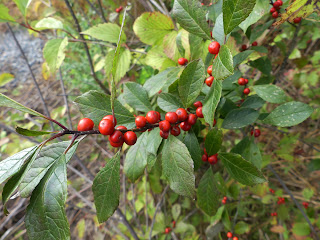Winterberry Holly
Last autumn's trip to Great Swamp also turned up another berry-producing plant besides yesterday's Autumn Olive and the previous day's Southern Arrowwood. It's a Winterberry Holly. Environmentally the Winterberry Holly is closer to the Southern Arrowwood in that they're both native plants and are considered excellent winter food for our bird friends. While a springtime robin might feast on a juicy worm, a wintertime robin needs berries like these to get by when insects and other invertebrates are rare.
There is a downside to them; apparently they're poisonous to people, dogs, and cats. I'm not sure if dogs and cats tend to eat them; at least most of the cats I've known were uninterested in eating most vegetation. (Some dogs admittedly seem to consider anything that fits in their mouths to be food.)
Winterberry Holly is - like most hollies - a dioecious (pronounced something like DIE-ee-shus) plant; there are separate male and female plants. Only the female plants produce berries, and then only if they've been fertilized by a nearby male plant.
They are also - unlike most hollies - deciduous; they will lose their leave in the winter.





Comments
Post a Comment